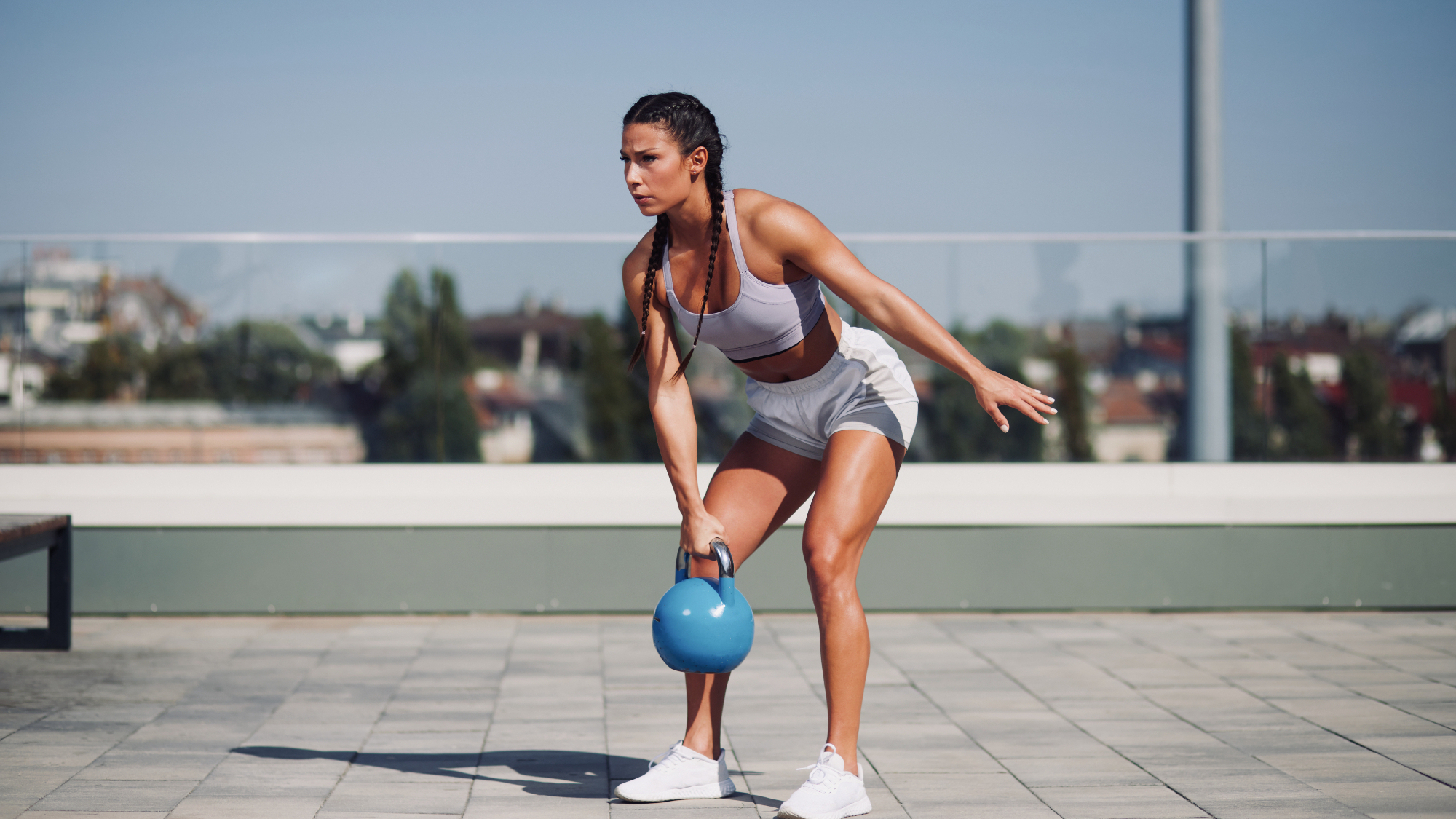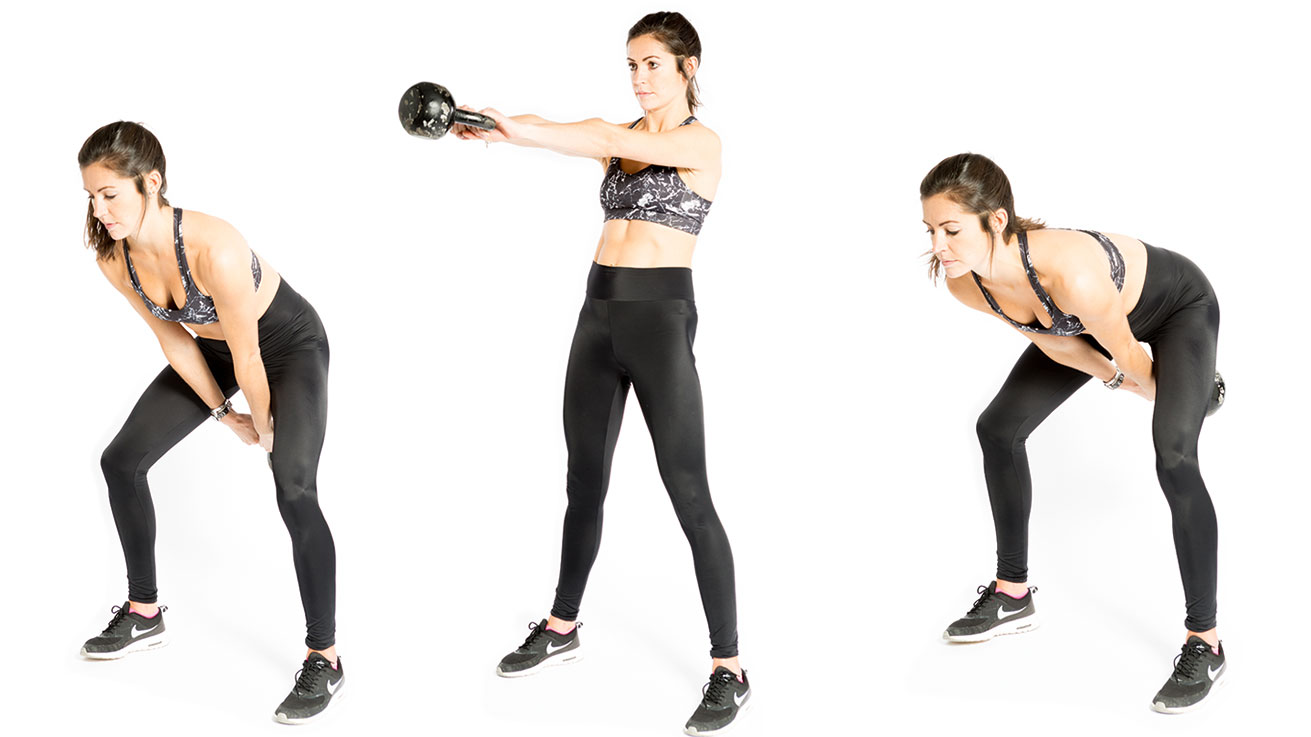Learn how to do a kettlebell swing to work your core and boost your metabolism
We asked a personal trainer how to do a kettlebell swing, whether they're good for beginners, and tips to improve your form


Learning how to do a kettlebell swing is one of the most effective training strategies. This single move works your whole body and utilizes your glutes, core, legs, and arms.
You're ready to go once you've got a weight, like one of the best kettlebells. That's the great thing about kettlebell swings; you don't need much equipment, just the weight and a bit of space.
This multi-muscle compound exercise offers a full-body workout, boosts your metabolism, and strengthens your core. According to a study published in the Journal of Strength and Conditioning Research, kettlebell swings can raise your heart rate as much as a treadmill workout.
To help you learn how to do a kettlebell swing, get the most from your training, and avoid injury, we spoke to personal trainer Kim Perry. Plus, we asked her whether it's a good move for beginners and tips to improve your form.
Kim Perry is a US-based personal trainer certified in Pre and Post-Natal training. She runs virtual training programs to help new and moms-to-be stay active and hit their fitness goals. Kim is also the You're Glowing podcast, which touches on motherhood, wellbeing, and lifestyle tips.
How to do a kettlebell swing

- Stand with your feet shoulder-width apart with a kettlebell on the ground between your legs.
- Hinge at your hips without going into a squat position, grab the kettlebell's handle, and swing it back between your legs.
- As it reaches behind you, drive your hips forward, and engage your core, using the momentum to bring the kettlebell to shoulder height as you stand up.
- Your lower body and core should drive the movement, not your arms.
- As the weight falls, drive your hips back, retake a squat position, and swing the kettlebell back between your legs.
- Train for 45 seconds, take a 30-second rest, then repeat up to five times for a full-body workout.
How to do a single-arm kettlebell swing

- Stand with your feet shoulder-width apart with a kettlebell on the ground between your legs.
- Hinge at your hips without going into a squat position, grab the kettlebell's handle with one hand, and swing it back between your legs.
- As it reaches behind you, drive your hips forward, and engage your core, using the momentum to bring the kettlebell to shoulder height as you stand up.
- Your lower body and core should drive the movement, not your arms.
- As the weight falls, drive your hips back, retake a squat position, and swing the kettlebell back between your legs.
- Train for 45 seconds, take a 30-second rest, then repeat with the other arm.
- Repeat the circuit up to five times.
How to do an alternating kettlebell swing

- Stand with your feet shoulder-width apart with a kettlebell on the ground between your legs.
- Hinge at your hips without going into a squat position, grab the kettlebell's handle with one hand, and swing it back between your legs.
- As it reaches behind you, drive your hips forward, and engage your core, using the momentum to bring the kettlebell to shoulder height as you stand up.
- Your lower body and core should drive the movement, not your arms.
- At the top of the swing, carefully switch the kettlebell into your other hand.
- As the weight falls, drive your hips back, retake a squat position, and swing the kettlebell back between your legs.
- Train for 45 seconds, take a 30-second rest, then repeat up to five times for a full-body workout.
Are kettlebell swings good for beginners?
The kettlebell swing is an excellent exercise for beginners as you don't need much equipment, and strengthening your core helps connect your upper and lower body, an advantage in many other activities.
This is why it is also an essential part of any kettlebell workout for beginners. But before you start doing 100 kettlebell swings a day, you must perfect your technique and get the form right.
It's best to take your time with repetitions as you learn how to do a kettlebell swing. This way, you can develop your mind-muscle connection and feel how different areas of your body move.
Get the Fit&Well Newsletter
Start your week with achievable workout ideas, health tips and wellbeing advice in your inbox.
Can you use kettlebell swings to work your core?
Kettlebell swings work your whole body but primarily develop strength in your legs and lower body, according to research published in the Sports Biomechanics journal.
However, your core connects your upper body, where you're holding the load, and your lower body. So, regularly doing kettlebell swings helps build a stronger core, which has several significant benefits.
Developing your core, a section of mid-body muscle that includes your abdominal muscles (abs), improves your balance, stability, and posture and promotes circulation for more effective post-workout recovery.
Can you use kettlebell swings to boost your metabolism?
Kettlebell swings work muscles all over your body, and they need oxygen from your blood to keep moving. Your heart pumps faster to get oxygenated blood to the muscles, which increases your heart rate.
As a result, you burn more energy during your workout than if you did a more traditional strength training move like a biceps curl. Sustaining this elevated heart rate also boosts your metabolism in the longer term.
And if you aim to do multiple sets of kettlebell swings for a set amount of time, like 30 seconds or a minute, it's a great example of high-intensity resistance training (HIRT).
According to research published in the Journal of Translational Medicine, HIRT increases your resting metabolic rate, the amount of energy you burn throughout the day while not exercising.
How do you know if you're doing kettlebell swings correctly?
"One of my favorite suggestions is to take a video of yourself! This helps me so much with my form. Look for straight arms, a slight bend in your knees, and a flat back," which will help engage your core, says Kim.
Perfecting your form is crucial to engage the correct muscles, use the kettlebell swings to work your abs, avoid pain in your lower back, or otherwise injure yourself while working out with weights.
When you first start, you may experience some lower back pain; this is common, but you can avoid this by tensing the muscles around your stomach that form your core muscle.
However, if this lower back pain becomes more severe or doesn't stop after you engage your core, it's important to stop and talk to a professional to avoid long-term injury.
What are the benefits of kettlebell swings?
Since you can arrange kettlebell swings into a HIRT workout, they're a fantastic option for building strength and burning fat, even when you're short on time.
The Physical Activity Guidelines for Americans recommends weekly cardio and strength training to burn calories, build lean muscle, and improve mobility as you age. The kettlebell swing blends both training techniques in a single move.
This makes them ideal for when an extended workout session is off the cards, allowing you to work your whole body, strengthen your core, and boost your metabolism with a single weight.
"It gives you so much bang for your buck," says Kim. "You are getting your cardio in as well as strength and power. You are working very efficiently with this move."
As it's such an effective full-body workout, you'll likely feel the effects of delayed-onset muscle soreness (DOMS) the next day. You can aid your recovery and reduce this post-workout pain by making sure to get enough protein in your diet.
Your body uses protein to repair the small tears in your muscle fibers caused by your training. You can get protein from food, but many people find a shake with one of the best protein powders for weight loss a convenient way to stay topped up.

Mollie is a lifestyle journalist who regularly contributes to publications including Insider, Cosmopolitan, The Metro, Healthline, HelloGiggles, Reviewed, HuffPost, Independent, and Fabulous, amongst others. Particularly, Mollie covers health and beauty. Basset Hounds are Mollie's favourite things on the earth - she has her own named Olive. Mollie loves anything with too much sugar in, the color yellow, pop culture, and musical theatre.